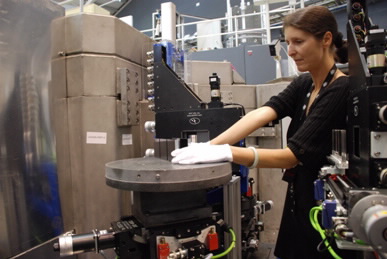 |
| Dr Christine Rehm working on the Kookaburra ultra- small-angle-neutron-scattering instrument. |
ANSTO has been given the green light to start testing its latest instrument, affectionately known by scientists as Kookaburra.
Kookaburra is an ultra-small-angle neutron scattering (USANS) instrument, and will open up brand new areas of study, and partnerships with local and international research organisations.
Once approved for use, the instrument will provide research insights in areas as diverse as mining, food and petrochemicals, and will enable scientists to see materials’ structure at the nanoscale. Kookaburra took around three years to design and construct, represents an investment of up to $3 million, and is the eleventh neutron beam instrument to be brought online at ANSTO.
Last week Kookaburra was given approval by the independent nuclear regulator, the Australian Radiation Protection and Nuclear Safety Agency (ARPANSA), to commence testing.
Dr Christine Rehm is the Kookaburra Instrument Scientist at ANSTO’s Bragg Institute. She predicts Kookaburra will open up brand new areas of study and opportunities for research partnerships.
“We’ve got microscopes that can see to the microscopic level, and other instruments that can see individual atoms. Kookaburra will let us see the nanoscale: the gaps in between,” Dr Rehm said.
“This new instrument will have applications for the minerals industry, for studying the magnetic properties of electronic devices, and for studies of food, water and chemicals.
“It will help us measure stress changes in rocks and how they change in time, which will assist in studies of how water moves.
“It will even enable us to measure the size of particles in food, with applications in new research pertaining to matters of food texture, flavour and shelf life.
“Suffice to say, we’re excited to have this instrument approved for testing, and excited about the opportunities it will bring to further strengthen our research partnerships with industry.”
Neutrons are non-destructive but can penetrate materials deeply. When they strike targets in our instruments they scatter, producing distinctive patterns that provide information to our researchers. At ANSTO, neutrons are produced by the OPAL reactor and directed through shielded, precision-engineered guide tubes to research targets in neutron beam instruments such as Kookaburra.
This process, known as neutron scattering, permits scientists to explore the structure and dynamics of materials under different conditions at atomic or molecular levels.
Through ANSTO, shire residents have one of the world’s most highly regarded centres for science in their backyard. Researchers travel from across the world to use our instruments, and to study health, environment, and ways of driving innovation for industry.


